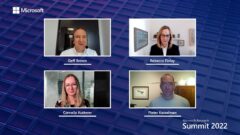Homomorphic Encryption with Microsoft SEAL
Since the invention of its first scheme in 2009, homomorphic encryption has been making it possible to perform computations on encrypted data, providing an opportunity to offer greater security assurances to customers using and storing their personal information in the cloud. But implementations of the technology haven’t always been accessible to those creating services people have come to rely on, requiring developers have an expertise in cryptography. In 2015, Microsoft Research released Microsoft Simple Encrypted Arithmetic Library, or Microsoft SEAL, an easy-to-use homomorphic encryption library written in C++ with no external dependencies. Available publicly on Github the library offers detailed examples on how to properly and securely use the technology.
In this webinar led by researcher Kim Laine of the Cryptography and Privacy Research group at Microsoft, you’ll learn how SEAL can help software engineers develop data storage and computation services that customers can feel safe using because their personal information is never exposed.
Together, you’ll explore:
- The three stages of data privacy;
- The motivation behind and the evolution of Microsoft SEAL;
- The core operations of Microsoft SEAL, including rotations of encrypted vectors and serialization;
- The feasibility of building real-world applications.
Resource list:
- Microsoft SEAL (opens in new tab) (Project page)
- Installing Microsoft SEAL on Linux & macOS (opens in new tab) (Video walk-through)
- Installing Microsoft SEAL on Windows (opens in new tab) (Video walk-through)
- Cryptography and Privacy Research (opens in new tab) (Research group)
- Kim Laine (opens in new tab) (Researcher profile)
*This on-demand webinar features a previously recorded Q&A session and open captioning.
This webinar originally aired on August 21, 2019
Explore more Microsoft Research webinars: https://aka.ms/msrwebinars (opens in new tab)
- Date:
- Haut-parleurs:
- Kim Laine
- Affiliation:
- Microsoft Research
-
-

Kim Laine
Principal Researcher
-
-
Regardez suivant
-
-
Microsoft Research India - who we are.
Speakers:- Kalika Bali,
- Sriram Rajamani,
- Venkat Padmanabhan
-
End-to-End Encrypted Group Chats with MLS: Design, Implementation and Verification
Speakers:- Théophile Wallez
-
-
-
-
-
Research talk: Differentially private fine-tuning of large language models
Speakers:- Huishuai Zhang,
- Melissa Chase
-
Microsoft Research 2022 Global PhD Fellowship Recipients
Speakers:- Kangle Deng,
- Paulo Freitas de Araujo Filho,
- Simla Harma
-
ASPLOS'22 - Session 2B | Revizor: Testing Black-box CPUs against Speculation Contracts
Speakers:- Oleksii Oleksenko










